| Contents
Home
General
Info
Ordering
Info
Contact us
Cartridge
Lists
Patent & Miscellaneous
Rim Fire
Center Fire Pistol
Center Fire Rifle
Metric Rimfire,
Pistol&Rifle
British Pistol and Rifle
Shotgun Shells
Cartridge Boxes &
Related
Posters
This Month's Picture Page
Index to
Picture Pages
Prior Picture Pages:
*
September 2003
*
October 2003
*
November 2003
*
December 2003
*
January 2004
*
February 2004
*
March 2004
*
April 2004
*
May 2004
*
June 2004
*
July 2004
*
August 2004
*
September 2004
*
October 2004
*
November 2004
*
December
2004
*
January 2005
*
February
2005
*
March
2005
*
April
2005
*
May 2005
* June 2005
* July 2005
*
August 2005
*
September
2005
*
October 2005
*
November 2005
*
December 2005
*
January 2006
*
February 2006
*
March 2006
*
April 2006
*May 2006
*June 2006
*July 2006
*August
2006
*September
2006
*October
2006
*November
2006
*December
2006
*January
2007
*February
2007
*March
2007
*April
2007
*May
2007
*June
2007
*July
2007
*August
2007
*September
2007
*October
2007
*November
2007
*December
2007
*January
2008
*February
2008
*March
2008
*April
2008
*May
2008
*June
2008
*July
2008
*August
2008
*September
2008
*October
2008
*November
2008
*December
2008
*January
2009
*February
2009
*March
2009
*April
2009
*May
2009
*June
2009
*July
2009
*August
2009
*September
2009
*October
2009
*November
2009
*December
2009
*January
2010
*February
2010
*March
2010
*April
2010
*May
2010
*June
2010
*July
2010
*August
2010
*September
2010
*October
2010
*November
2010
*December
2010
*January
2011
*February
2011
*March
2011
There are no picture pages
for April thru June 2011
*July
2011
*August
2011
*September
2011
*October
2011
*November
2011
*December
2011
*January
2012
*February
2012
*March
2012
*April
2012
*May
2012
*June
2012
*July
2012
*August
2012
*September
2012
*October
2012
*November
2012
*December
2012
*January
2013
*February
2013
*March
2013
*April
2013
*May
2013
*June
2013
*July
2013
*August
2013
*September
2013
*October
2013
*November
2013
*December
2013
*January
2014
*February
2014
*March
2014
*April
2014
*May
2014
*June
2014
*July
2014
*August
2014
*September
2014
*October
2014
*November
2014
*December
2014
*January
2015
*February
2015
Links to Other Sites
Cartridge Collectors Organizations:
IAA
ECRA
SAAACA
Auctions:
Auction
Arms
E-Bay
Ward's Collectibles
Sold USA
Books:
Armory
Publications
WCF Publications
Other Collector's Sites:
Curtis Steinhauer
|
Home of the Old Ammo Guy's Virtual
Cartridge Trading Table
Picture Page
March 2015
Bannerman's 1927 Military Goods
Catalog.......
I purchased a collection of cartridges and reference materials this past
month, and included in it were four editions of Francis Bannerman Sons
Illustrated and Descriptive
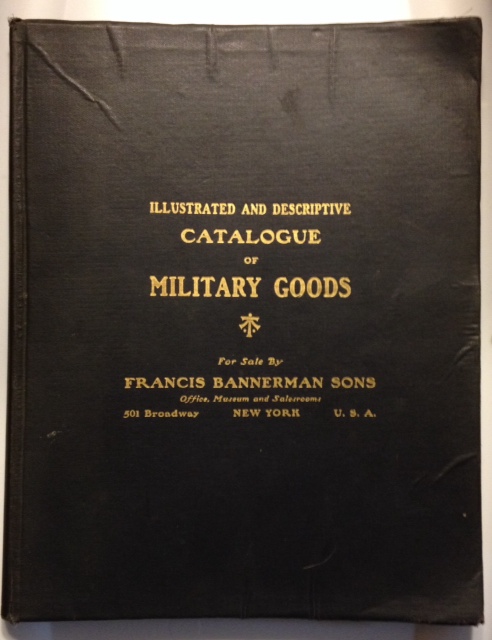 Catalogue of Military Goods from 1927, 1940,
1945 and 1949. The 1927 edition is 370 pages, nicely bound with black cloth
covers and gold embossed lettering on the front and spine. The other three
are stapled together, and haven't survived the wear and tear of the
intervening years as well as the older bound edition. These Bannerman
catalogs are a great source of information on arms and ammunition, as well
as other mostly military items, as they provide detailed descriptions with
historical background information, and quality illustrations or in some
cases photographs for most of the items they sold. Francis Bannerman was
born in Dundee, Scotland in March of 1851 to a family in which the tradition
was to name the eldest son Francis, and he was the sixth in a line of
so-named sons, his father also being one of those eldest sons named Francis.
His family came to America in 1854, and found a home near the Brooklyn Navy
Yard. Frank, as Francis Bannerman VI came to be known, attended school until
the start of the Civil War, when his father enlisted in the Union Army and
Frank had to withdraw from school at the age of ten to help support the
family. He returned to school following his father's discharge from military
service at the end of the war, but found little opportunity to attend full
time due to the need to assist his father in his ship chandlery store, which
grew out of a scavenged junk business to one that was eventually purchasing
military goods at US Navy auctions, primarily worn rope for resale to paper
makers. In 1872, with his father's blessing, Frank set up a naval surplus
goods business in competition with his father. At an early age he had
observed old military muskets and swords being destroyed for scrap, and
knowing that there was demand for these old weapons in smaller countries
that were unable to afford modern weapons, he began attending Army auctions
and buying up these obsolete weapons. He was also aware that many of these
weapons had historical significance and were worthy of preservation. As a
result, he began publishing his catalog, illustrating and providing the
history of the weapons he had to sell. A New York Sun reporter wrote that
"Bannerman could tell an interesting story about everything he had for
sale". His catalog is given much of the credit for the beginning of gun
collecting among the middle class in this country, who previously only
purchased guns that were needed for food or protection. Over the next 25
years, Bannerman's developed into the world's largest seller of surplus
military equipment, and the growth of his business required several moves to
gain needed storage space. At the start of the Spanish-American War in 1897,
Bannerman's salesroom and warehouse was at 501 Broadway in New York City.
From this location, they outfitted many of the American volunteer regiments.
As the war wound down they purchased weapons directly from the Spanish
government before it evacuated Cuba, and then purchased 90% of the guns,
ammunition and equipment captured by the US military and auctioned off by
the government. These purchases necessitated that Frank Bannerman find a
remote location to safely store the 30 million (give or take a few million)
cartridges and artillery projectiles that he had obtained. He purchased Polopels Island in the Hudson River in 1900 for this purpose, upon which he
had constructed storehouses and a summer residence, all patterned after the
castles in his native Scotland. In the side of the largest castle-like
storehouse were the words "Bannerman's Island Arsenal". Consequently, the
island became known as Bannerman's Island, and the largest structure,
Bannerman's Castle. They continued to maintain the 501 Broadway location as
their retail outlet and showroom. Construction was ongoing on the island
until Bannerman's death in 1918. In August 1920, two hundred tons of
artillery shells and powder exploded destroying the powder house. State and
Federal firearms legislation severely impacted sales to civilians over the
years, and by 1957, Bannerman's island was pretty much abandoned. In 1958,
Frank Bannerman's grandchildren had the remaining ordnance on the island removed, allowed
the Smithsonian to select items for the museum collection, and auctioned off
the remaining items, The State of New York took ownership of the island and
buildings in 1967, and tours of the island were conducted beginning in 1968.
On August 8, 1969, a fire began in the Arsenal and over the next three days
destroyed the roof and floors, leaving just the walls standing. Today the
Arsenal is in ruins, with much of the structure remaining after the fire
having collapsed.. Catalogue of Military Goods from 1927, 1940,
1945 and 1949. The 1927 edition is 370 pages, nicely bound with black cloth
covers and gold embossed lettering on the front and spine. The other three
are stapled together, and haven't survived the wear and tear of the
intervening years as well as the older bound edition. These Bannerman
catalogs are a great source of information on arms and ammunition, as well
as other mostly military items, as they provide detailed descriptions with
historical background information, and quality illustrations or in some
cases photographs for most of the items they sold. Francis Bannerman was
born in Dundee, Scotland in March of 1851 to a family in which the tradition
was to name the eldest son Francis, and he was the sixth in a line of
so-named sons, his father also being one of those eldest sons named Francis.
His family came to America in 1854, and found a home near the Brooklyn Navy
Yard. Frank, as Francis Bannerman VI came to be known, attended school until
the start of the Civil War, when his father enlisted in the Union Army and
Frank had to withdraw from school at the age of ten to help support the
family. He returned to school following his father's discharge from military
service at the end of the war, but found little opportunity to attend full
time due to the need to assist his father in his ship chandlery store, which
grew out of a scavenged junk business to one that was eventually purchasing
military goods at US Navy auctions, primarily worn rope for resale to paper
makers. In 1872, with his father's blessing, Frank set up a naval surplus
goods business in competition with his father. At an early age he had
observed old military muskets and swords being destroyed for scrap, and
knowing that there was demand for these old weapons in smaller countries
that were unable to afford modern weapons, he began attending Army auctions
and buying up these obsolete weapons. He was also aware that many of these
weapons had historical significance and were worthy of preservation. As a
result, he began publishing his catalog, illustrating and providing the
history of the weapons he had to sell. A New York Sun reporter wrote that
"Bannerman could tell an interesting story about everything he had for
sale". His catalog is given much of the credit for the beginning of gun
collecting among the middle class in this country, who previously only
purchased guns that were needed for food or protection. Over the next 25
years, Bannerman's developed into the world's largest seller of surplus
military equipment, and the growth of his business required several moves to
gain needed storage space. At the start of the Spanish-American War in 1897,
Bannerman's salesroom and warehouse was at 501 Broadway in New York City.
From this location, they outfitted many of the American volunteer regiments.
As the war wound down they purchased weapons directly from the Spanish
government before it evacuated Cuba, and then purchased 90% of the guns,
ammunition and equipment captured by the US military and auctioned off by
the government. These purchases necessitated that Frank Bannerman find a
remote location to safely store the 30 million (give or take a few million)
cartridges and artillery projectiles that he had obtained. He purchased Polopels Island in the Hudson River in 1900 for this purpose, upon which he
had constructed storehouses and a summer residence, all patterned after the
castles in his native Scotland. In the side of the largest castle-like
storehouse were the words "Bannerman's Island Arsenal". Consequently, the
island became known as Bannerman's Island, and the largest structure,
Bannerman's Castle. They continued to maintain the 501 Broadway location as
their retail outlet and showroom. Construction was ongoing on the island
until Bannerman's death in 1918. In August 1920, two hundred tons of
artillery shells and powder exploded destroying the powder house. State and
Federal firearms legislation severely impacted sales to civilians over the
years, and by 1957, Bannerman's island was pretty much abandoned. In 1958,
Frank Bannerman's grandchildren had the remaining ordnance on the island removed, allowed
the Smithsonian to select items for the museum collection, and auctioned off
the remaining items, The State of New York took ownership of the island and
buildings in 1967, and tours of the island were conducted beginning in 1968.
On August 8, 1969, a fire began in the Arsenal and over the next three days
destroyed the roof and floors, leaving just the walls standing. Today the
Arsenal is in ruins, with much of the structure remaining after the fire
having collapsed..
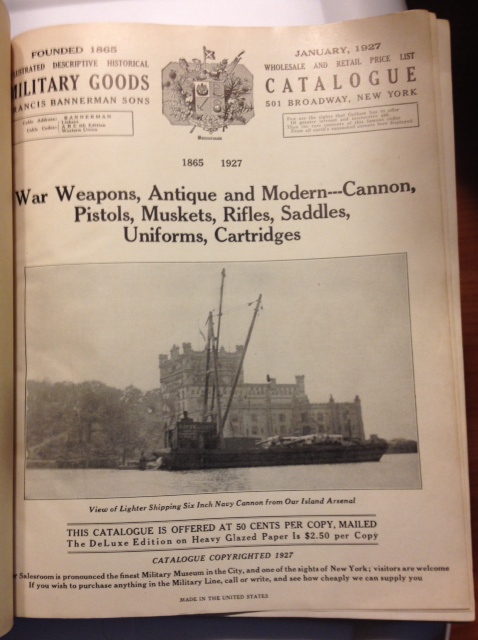
.
This page shows a view of the 'Bannerman's Island Arsenal', the most
prominent building on Polepel's Island. This is the building that burned in
1969.
.
.
.
.
.
.
.
.
.
.
.
.
.
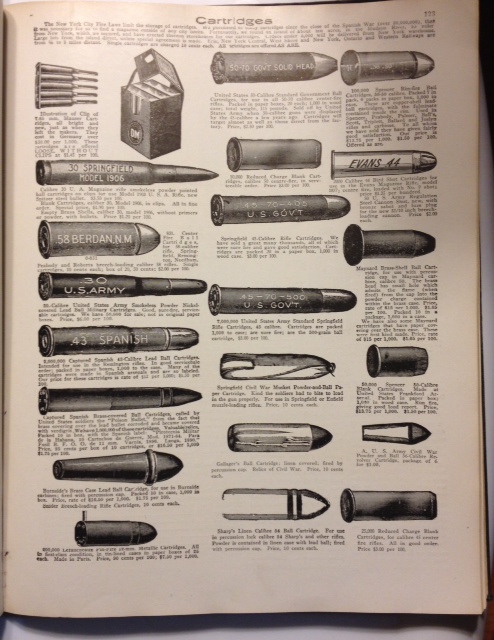
This is one of several pages devoted primarily to cartridges, however,
cartridges are also scattered throughout the firearms sections of the
catalog, listed with the specific weapons that were chambered for them.
.
.
.
.
.
.
.
.
.
.
.
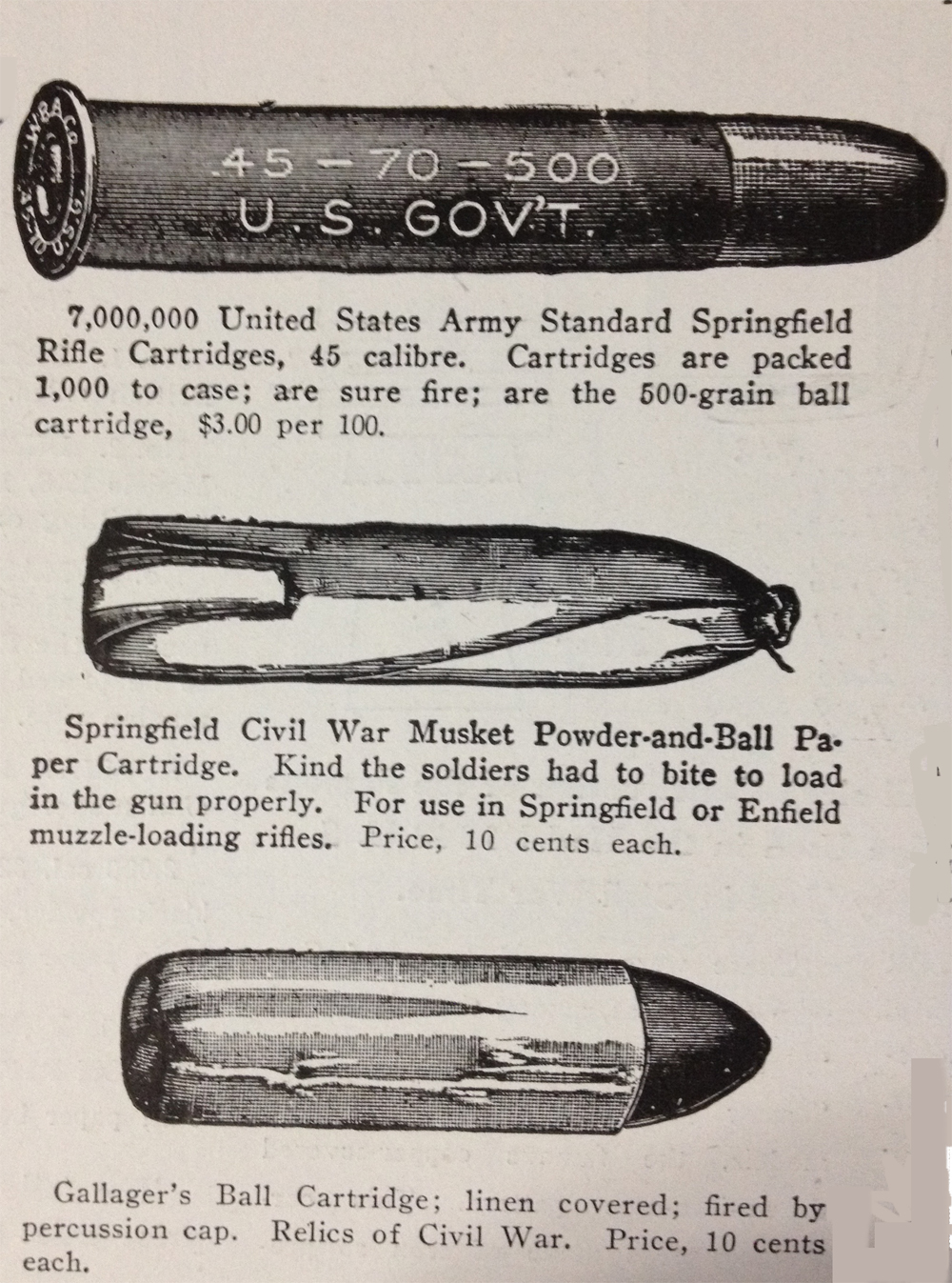
From the left column of the page shown above are these cartridges,
including the W.R.A.Co. .45-70 U.S.G. headstamped example, of which
Bannerman had 7 million. I can't begin to imagine 350,000 boxes of
Winchester .45-70. The Springfield musket and Gallager's carbine cartridges
at 10 cents each sound like a great deal, but considering these are 1927
prices when a new Ford Model T could be had for under $400, puts these
cartridge prices into perspective.
.
.
.
.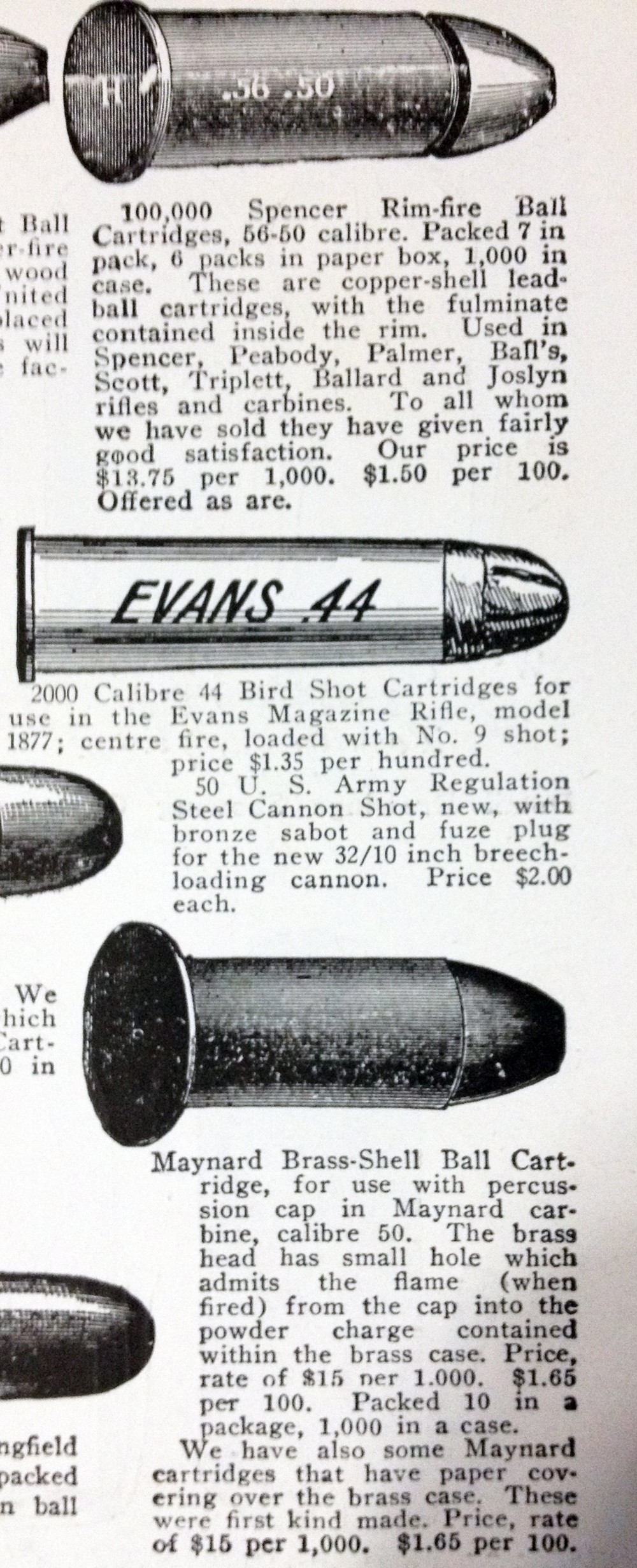
These cartridges are pictured on the upper right of the page shown above.
Again, great prices for Spencer, Evans and Maynard cartridges from today's
perspective. The Evans shot cartridge is quite unusual, with it's paper
bullet. I believe these are attributed to the Phoenix Metallic Cartridge
Company, which held the patent for the shot-filled segmented paper bullet.
.
.
.
.
.
.
.
.
.
.
.
.
.
.
.
.
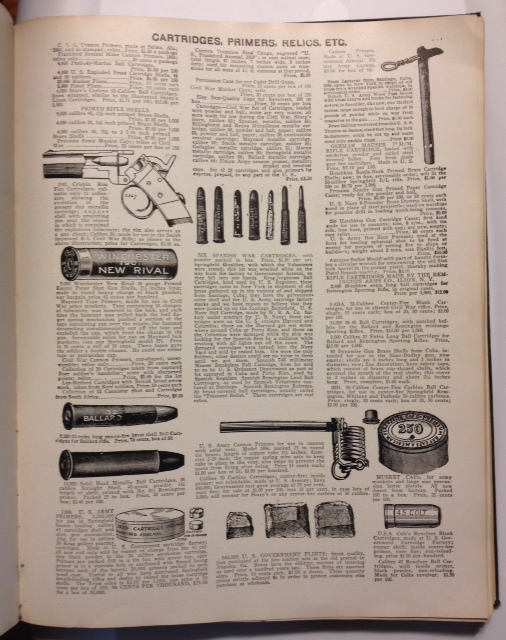
Another of the pages devoted primarily to cartridges. The descriptions
usually include some historical facts related to the cartridges being sold,
including where and under what circumstances they were obtained. These facts
were included by Bannerman to give the cartridges some intrinsic (collector)
value over and above their value as shooting ammunition.
.
.
.
.
.
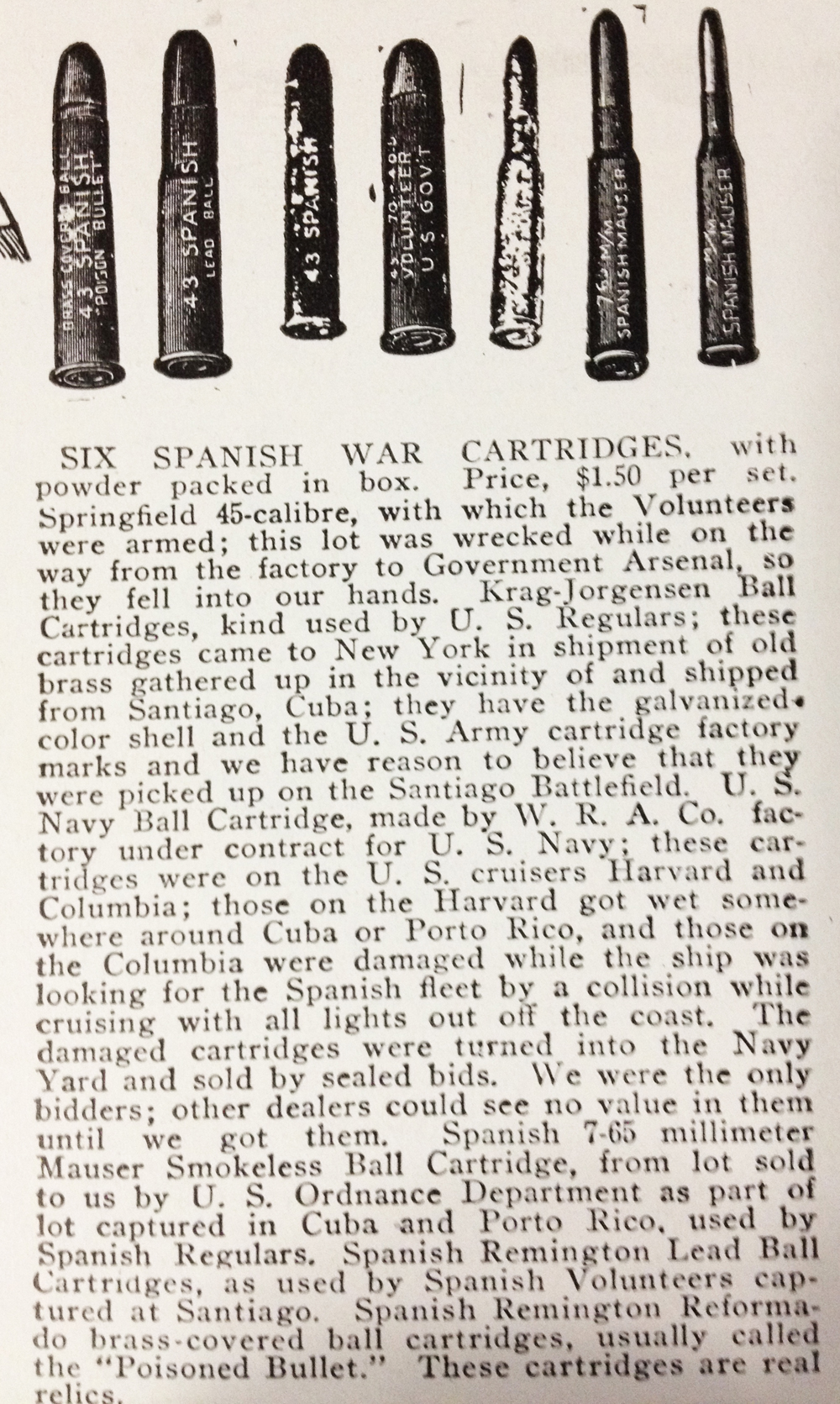
The most interesting item to me on the page shown above to is the set of
six Spanish War cartridges, ranging from battlefield pickups, cartridges
damaged in shipping or at sea, or captured in war. Note the 'Poisoned
Bullet' reference to the Spanish Reformado cartridge, a misnomer that
originated as a result of the green verdigris that is usually found on their
brass jacketed bullets and resulted from the reaction of the bullet
lubricant with the brass jacket. At $1.50 for the six, or 25 cents each,
these seem to be rather pricey compared to other cartridges in the catalog.
.
.
.
.
.

Two cartridges that appear out of place in a military goods catalog are
these, also from the page shown above. The upper one is the 32-40 Ballard
and the lower one the .38-40 Remington Straight; both seem reasonably priced
at about 1.5 cents per cartridge.
.
.
..
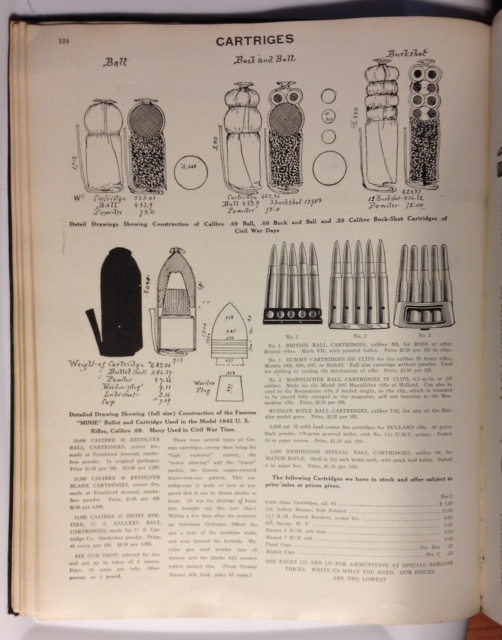
Another page with diagrams and descriptions of paper cartridges loaded
with a round ball and a Minie bullet.
.
.
.
.
.
.
.
.
.
.
.
.
.
.
.
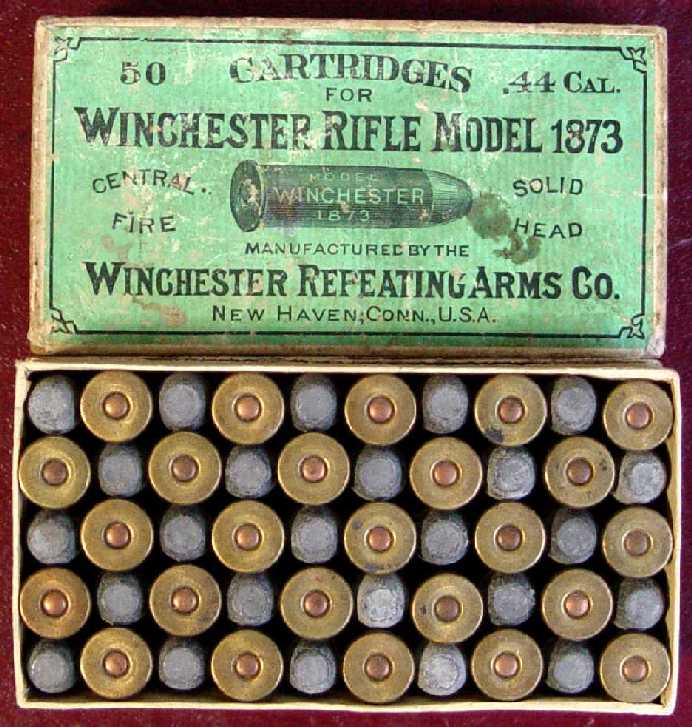
|




